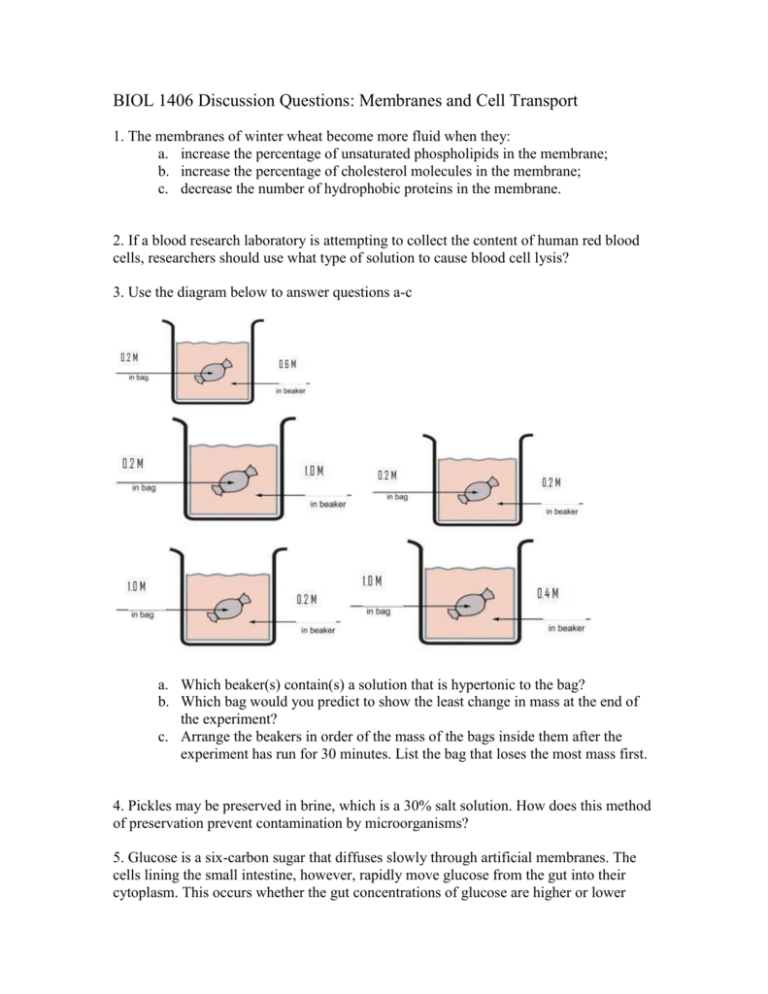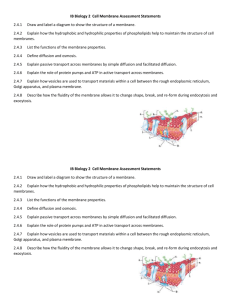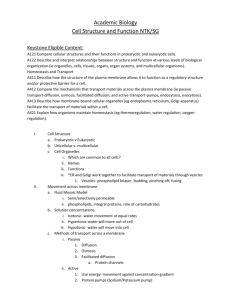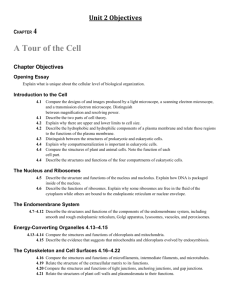3. Membranes and Cell Transport
advertisement

BIOL 1406 Discussion Questions: Membranes and Cell Transport 1. The membranes of winter wheat become more fluid when they: a. increase the percentage of unsaturated phospholipids in the membrane; b. increase the percentage of cholesterol molecules in the membrane; c. decrease the number of hydrophobic proteins in the membrane. 2. If a blood research laboratory is attempting to collect the content of human red blood cells, researchers should use what type of solution to cause blood cell lysis? 3. Use the diagram below to answer questions a-c a. Which beaker(s) contain(s) a solution that is hypertonic to the bag? b. Which bag would you predict to show the least change in mass at the end of the experiment? c. Arrange the beakers in order of the mass of the bags inside them after the experiment has run for 30 minutes. List the bag that loses the most mass first. 4. Pickles may be preserved in brine, which is a 30% salt solution. How does this method of preservation prevent contamination by microorganisms? 5. Glucose is a six-carbon sugar that diffuses slowly through artificial membranes. The cells lining the small intestine, however, rapidly move glucose from the gut into their cytoplasm. This occurs whether the gut concentrations of glucose are higher or lower than the glucose concentrations in intestinal cell cytoplasm. Using this information, which transport mechanism is most likely responsible for the glucose transport in intestinal cells? Why? 6. Consider the transport of protons and sucrose into a plant cell by the sucrose-proton cotransport protein. Plant cells continuously produce a proton gradient by using the energy of ATP hydrolysis to pump protons out of the cell. Why, in the absence of sucrose, don't protons move back into the cell through the sucrose-proton cotransport protein? 7. While on a trip to the desert, a friend of yours was bitten by a rattlesnake. He nearly died from hemolysis, or breakage of many of his red blood cells. You have analyzed the snake venom and found three enzymes: phospholipase, which degrades phospholipids; neuraminidase, which removes cell surface carbohydrates; and protease which degrades proteins. Which of these enzymes do you think was responsible for his near fatal red blood cell hemolysis? Why? (Question adapted from The Biology Project) 8. If a cell membrane were composed of only a phospholipid bilayer, what properties would it have? 9. Ethanol, the active ingredient in alcoholic beverages, is a small, polar, and uncharged molecule. Would you predict that this molecule crosses cell membranes quickly or slowly? Explain your reasoning. 10. What functions might each of the three types of diffusion serve in an independent cell like a Paramecium or an amoeba? in a multicellular organism—for example, a human or a tree? 11. Would you expect an amoeba that lives in a pond in a cold northern climate to have a higher or lower percentage of saturated fatty acids in its membranes during the summer as compared to the winter? Explain your answer. 12. When biomedical researchers design drugs that must enter cells to be effective, they sometimes add methyl (–CH3) groups to make the drug molecules more likely to pass through cell membranes. Conversely, when researchers design drugs that act on the exterior of cell membranes, they sometimes add a charged group to decrease the likelihood that the drugs will pass through membranes and enter cells. Explain why these strategies make sense. 13. Some elements can pass through the lipid bilayer rather quickly, while others take some time. Of the following, which would move through the lipid bilayer of a plasma membrane most rapidly? Why? CO2, an amino acid, glucose, K+, starch 14. One function of membrane proteins is transportation of substances across the membrane. If a cell biologist placed cells into an environment with a chemical that blocks the function of these transport proteins, which processes will be blocked? 15. One day during the summer you and some friends made ice cream using an electric ice cream maker. A few days later you noticed a yellow circle of dead grass where the ice cream freeze had been placed. What happened? 16. A laboratory assistant prepared solutions of 0.8 M, 0.6 M, 0.4 M, and 0.2 M sucrose, but forgot to label them. After realizing the error, the assistant randomly labeled the flasks containing these four unknown solutions as flask A, flask B, flask C, and flask D. Design an experiment, based on the principles of diffusion and osmosis that the assistant could use to determine which of the flasks contains each of the four unknown solutions. Include in your answer (a) a description of how you would set up and perform the experiment; (b) the results you would expect from your experiment; and (c) an explanation of those results based on the principles involved. 17. An artificial cell consisting of an aqueous solution enclosed in a selectively permeable membrane has just been immersed in a beaker containing a different solution. The membrane is permeable to water and to the simple sugars glucose and fructose but completely impermeable to the disaccharide sucrose. a. Which solute(s) will exhibit a net diffusion into the cell? b. Which solute(s) will exhibit a net diffusion out of the cell? c. Which solution is hypertonic to the other? d. In which direction will there be a net osmotic movement of water? 18. Diagram and describe the structure of a phospholipid molecule. 19. Explain what happens when a group of phospholipid molecules are placed in water. 20. Draw a diagram of the fluid mosaic model of membrane structure and label the following parts: phospholipid, cholesterol, transmembrane protein, peripheral protein, glycolipid, glycoprotein, filaments of cytoskeleton. 21. Describe the process of diffusion. 22. What types of substances can pass through cell membranes by simple diffusion and what types of substances cannot? 23. What is facilitated diffusion? 24. How is facilitated diffusion similar to simple diffusion? How are they different? 25. How are carrier proteins similar to channel proteins? How are they different?? 26. Describe the process of osmosis. 27. What happens when a cell is placed in a hypotonic solution? Explain why. 28. What happens when a cell is placed in a hypertonic solution? Explain why. 29. What happens when a cell is placed in an isotonic solution? Explain why. 30. Describe 3 different methods that organisms have evolved to maintain osmotic balance with their environment. 31. Explain the difference between passive transport and active transport. 32. Indicate which of the following transport mechanisms are active and which are passive: osmosis, phagocytosis, simple diffusion, facilitated diffusion, pinocytosis, carrier-mediated endocytosis, sodium-potassium pump, coupled transport. 33. How are endocytosis and exocytosis similar? 34. How are endocytosis and exocytosis different? 35. How are phagocytosis, pinocytosis, and receptor-mediated endocytosis similar? 36. How are phagocytosis, pinocytosis, and receptor-mediated endocytosis different? 37. Explain how the sodium-potassium pump works. 38. Describe the process of coupled transport. 39. In your working with the enzyme votase you discover that the enzyme is also a transmembrane protein (part of the protein crosses the lipid bilayer of the cell). a. Circle the portion of the sequence below that you would expect to be the transmembrane region of the protein. b. Why will the section you circled be embedded in the membrane? c.. Draw a schematic of the phospholipid bilayer. Label the lipid hydrocarbon chains, phosphate hydrophilic heads, and water. This material was created by or adapted from material created by MIT faculty members, Professor Eric Lander, Professor Robert A. Weinberg, Dr. Claudette Gardel, Introductory Biology, 2005, 7.012. Copyright © (2005) Professor Eric Lander, Professor Robert A. Weinberg, Dr. Claudette Gardel 42. Using the terms below: Option 1: Create a concept map using http://ctools.msu.edu/ctools/index.html Option 2: Create a working model using materials provided Be prepared to share with class active transport amphipathic molecule aquaporin concentration gradient cotransport diffusion electrochemical gradient electrogenic pump endocytosis exocytosis facilitated diffusion flaccid fluid mosaic model gated channel glycolipid glycoprotein hypertonic hypotonic integral protein ion channel isotonic ligand membrane potential osmoregulation osmosis passive transport peripheral protein phagocytosis pinocytosis plasmolysis proton pump receptor-mediated endocytosis selective permeability sodium-potassium pump tonicity transport protein turgid









